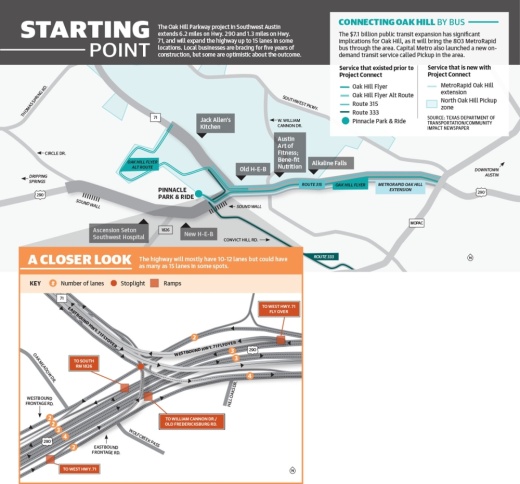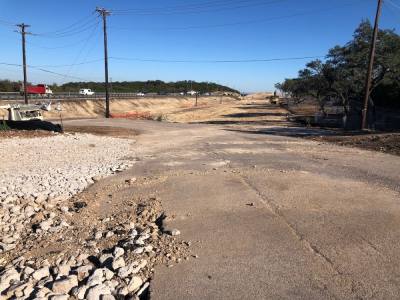Just eight months into his three-year lease, Lopez said he is considering moving away from his location that sits near the Hwy. 290 and William Cannon Drive intersection at the center of the Oak Hill Parkway project that is underway.
“The thing here is that we are trying to move. Even before the construction, we were like, ‘Oh yeah, this is a very crowded area for cars,’” Lopez said. “Also, [traveling] the other way, it’s a little bit harder to get into the plaza.”
The full force of construction has yet to affect Bene-Fit Nutrition, but the Texas Department of Transportation began major work on the eastern and westernmost sections of Hwy. 290 in Southwest Austin this fall.
The project, which will mostly have 10-12 total lanes but could have up to 15 lanes in certain spots, is expected to have traffic in its final setup by 2025, said Brad Wheelis, a public information officer with TxDOT. Construction will be totally complete in 2026, according to Wheelis.
The Oak Hill Parkway project encompasses a 7.5-mile stretch of road, including 6.2 miles on Hwy. 290 and 1.3 miles on Hwy. 71. In addition to widening the highway that connects downtown Austin to Dripping Springs, the work will add two flyovers linking Hwy. 290 and Hwy. 71 and cross street connections at Convict Hill Road, RM 1826, Scenic Brook Drive and Circle Drive.
The work will alleviate congestion on the roadway that saw daily traffic of 69,491 cars in 2019 and reached capacity in the 1990s, Wheelis said.
“One of the things that you’ll see right now on the Oak Hill Parkway is that traffic is already spilling into the neighborhoods,” Wheelis said.
Jay Blazek Crossley, executive director at Farm and City, a group focused on regional transportation policy, said the project will add congestion.
“The impact statement for that project, it very clearly says that they expect the fact that they’re doing the project to cause significant increases of traffic,” Crossley said. “They expect that ... the way they are doing [the project], it’ll cause a lot of sprawl and that will cause something like 50,000 more people to be driving on MoPac.”
Facing construction
The first signs of construction that Jonathan Pisana, owner of Austin Art of Fitness, noticed was the disappearance of the large oak trees, for which the area is named.
“I just came in one day and was like, ‘Oh, wow what’s different?’ It took me a while. I was like, ‘Oh, man all the trees are gone,’” Pisana said.
As part of its environmental impact statement, TxDOT looked at 518 large trees, those with a diameter greater than 10 inches. Of those, 281 needed to be removed.
A lawsuit spearheaded by environmental groups and some Oak Hill neighbors that aimed to halt construction on environmental grounds was denied in September, allowing work on the project to begin. Carol Cespedes, who is a longtime activist in the Oak Hill neighborhood, said it has been hard to watch others come down.
“It was heartbreaking,” Cespedes said.
Beyond the trees, Pisana, whose store is in the same strip mall as Lopez’ Bene-Fit Nutrition, said he does not anticipate the short-term construction having a large effect on his appointment-only business.
Pisana is hopeful that the project will help his business as the current layout of Hwy. 290 East presents challenges for drivers trying to turn left to access his shop.
Alkaline Falls owner Edgar Perez said having better access from Hwy. 290 to his location could help his business gain customers who might commute through the area to get to Central Austin or Bee Cave.
“That’s kind of one of the things that we had in mind opening up this spot,” Perez said. “‘I’m over here and coming out of work, I’ll pick up some water and take it home.’”
Perez said he hopes there is an exit closer to his store. Currently, customers have to exit about a mile and a half before his store.
TxDOT officials said outreach to businesses began in the late summer of 2020 with letters, emails and virtual briefings. The outreach will increase, as major construction begins to have a greater affect on businesses.
H-E-B was one of the first businesses to replace as the construction grew near. It moved from its location in the heart of the Y at Oak Hill to a new facility on Hwy. 290, west of the Y, on Oct. 27.
“H-E-B has been well-informed by TxDOT in regards to the Oak Hill Parkway for many years,” said Tamra Jones, a public affairs manager with H-E-B, in an email.
She added that the new location will be convenient for customers and allow them continued access to H-E-B’s selection of products and services.
Construction plans
TxDOT will start by building the frontage roads, which will expand up to four lanes for westbound traffic on Hwy. 290 near the Y. Once that work completes in 2023 or 2024, traffic will shift to the frontage roads to accommodate work on the highway lanes and cross street bridges.
Drivers can expect traffic shifts, including lane closures and a potential traffic light for westbound Hwy. 290 traffic turning onto Hwy. 71, Wheelis said. He added that crews will work at night to minimize changes to daytime traffic and shorten the project timeline.
Much of that construction will take place in front of businesses and homes.
“There’s going to be frontage roads, so you’re coming closer to some businesses [and] residences,” Wheelis said.
TxDOT has already begun preparing for bridges between MoPac and William Cannon Drive on Hwy. 290, construction on new Hwy. 290 frontage roads west of Hwy. 71, and two sound walls near the Ridgeview neighborhood and Bell Quarry Hills Apartments.
“A sound wall could lessen the impact. Sound walls do not prevent sound from coming in, so folks need to realize it’s a mitigation,” Wheelis said.
Bus options
The highway is not the only transportation project that figures to transform transportation in Oak Hill. Capital Metro’s Project Connect, the $7.1 billion public transit program, aims to bring its MetroRapid 803 line to the area. Sharmila Mukherjee, Capital Metro’s executive vice president of planning and development, said the goal is for the line to have buses, which would run through the western edge of downtown to the Domain, running every five minutes. The Oak Hill extension will not be complete until after the parkway project wraps up.
In addition to the MetroRapid extension, Capital Metro launched a new zone for its on-demand pickup service in the area in August as a part of Project Connect. As the area’s transportation landscape evolves over the next decade, business owners such as Perez are looking at the silver lining.
“It’s kind of one of those things that you don’t know until it happens. ... It could help out potentially,” Perez said.






